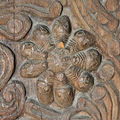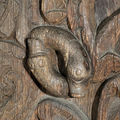Heddal stave church
The Heddal stave church (old German name Kirche zu Hitterdal ) is around 20 meters long and 26 meters high, the largest of its kind in Norway . It is located in the Heddal district of Notodden municipality directly on the European route 134 in the east of the province of Vestfold og Telemark .
history
According to legend, the troll Finn, who lived in Svintruberg not far from Heddal, built the church in just three days. Some art historians date the oldest parts of the stave church , especially the choir , back to the 12th century, but this is controversial. In essence, the building was probably built around 1240. A runic inscription near the south portal allows the conclusion that the church was consecrated on October 25, 1242. It is first mentioned in written sources in the 14th century.
From 1849 to 1851 the building was restored and heavily modified according to plans by the architects Nebelong and Hansen. In particular, windows were installed and the interior modernized. These interventions, some of which were improper, met with resistance from the population and experts. It was not until 1954 that the changes were dismantled using older drawings with the aim of restoring the medieval character of the church.
architecture
Due to its size and the large number of overlapping roofs, the stave church is sometimes referred to as the “Gothic wooden cathedral”. The three-aisled long church with a raised central space rests on twelve supporting masts, the so-called "rods". Resin-rich pine wood was used for the construction , which is regularly tarred according to medieval models to protect against rot. 25 to 30 percent of the original material has been preserved to this day. With the help of the radiocarbon method it could be proven that a beam of the basic construction dates from the time between 875 and 925, without it being possible to say what function it originally had. The church is surrounded by a so-called "Svalgang" (a kind of arcade ), which offers protection from wind and weather.
The entrance portals of the church have valuable carvings of pagan origin, the inside is decorated with rose patterns. The altar by an unknown artist was made in 1667, the wall paintings were created in 1668. A splendid chair ("bishop's chair") from the 12th century with motifs from the Nibelungen saga is worth noting . The medieval inventory originally included a wrought-iron chandelier for 23 candles, which is now in the Museum of Cultural History at the University of Oslo .
Services, weddings and baptisms are still held in the church. Guided tours are offered regularly. Heddal stave church is one of Norway's most visited tourist attractions today.
See also
- The Heddal bygdetun open-air museum is 300 m from the stave church .
- List of stave churches
literature
- Roar Hauglid : Norwegian stave churches . Dreyer Verl., Oslo (Norway) 1977, ISBN 82-09-00938-9 . (German translation; Norwegian original title: Norske stavkirker )
- Erich Burger: Norwegian stave churches. History, construction, jewelry . First published, DuMont, Cologne 1978 (= DuMont-Kunst-Taschenbücher; 69), ISBN 3-7701-1080-3 .
- Yasuo Sakuma, Ola Storsletten: The stave churches of Norway. Masterpieces of Nordic architecture . Approved license edition, Bechtermünz-Verl., Augsburg 1997, ISBN 3-86047-239-9 . (German translation)
Web links
Individual evidence
- ↑ Archived copy ( memento of the original dated August 1, 2012 in the Internet Archive ) Info: The archive link was inserted automatically and has not yet been checked. Please check the original and archive link according to the instructions and then remove this notice.
Coordinates: 59 ° 34 ′ 46.3 " N , 9 ° 10 ′ 34.6" E







